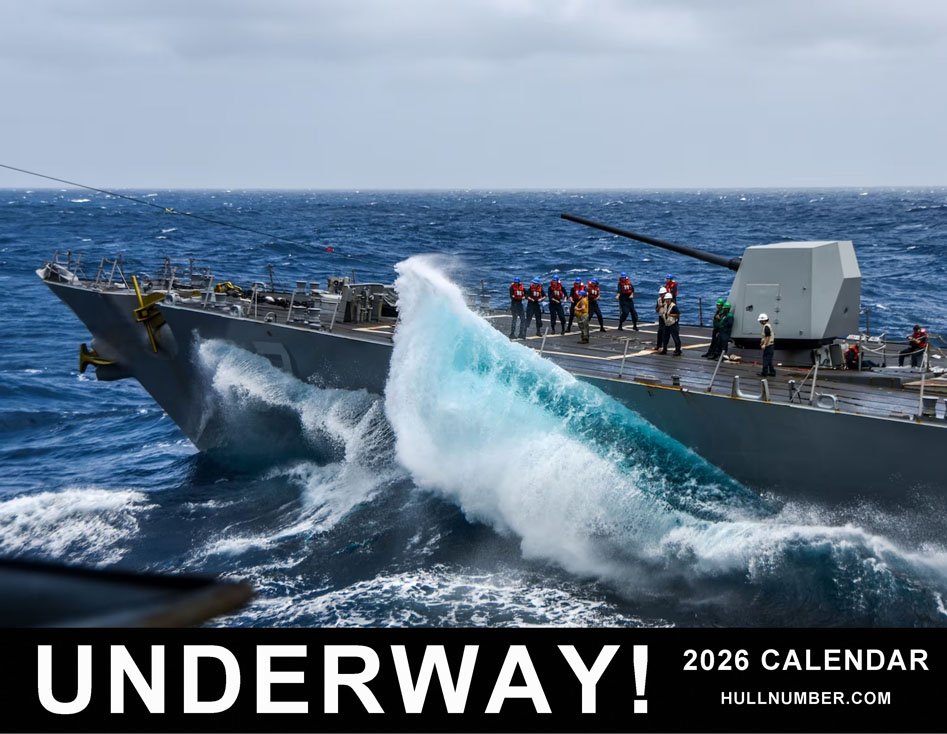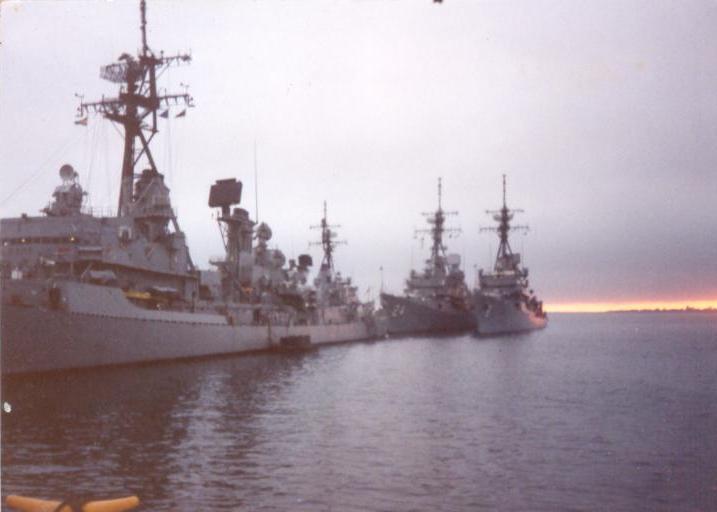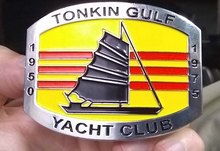 |
|||||||
| UNDERWAY! 2026 WALL CALENDAR is AVAILABLE - CLICK HERE |
|||||||
 |
|||||||
 |


U.S.S. WADDELL
(DDG-24)SEMPER CONFIDENS
Click to view crew list
USS WADDELL (DDG-24) - a Charles F. Adams-class guided missle destroyer
In Commission 1964 to 1992DDG-24 Deployments - Major Events
| Add a DDG-24 Shellback Initiation | Add a DDG-24 Deployment - Major Event | ||||
| Month | Year | to | Month | Year | Deployment / Event |
|---|---|---|---|---|---|
| FEB | 1962 | - | Keel Date: 6 FEB 1962 at Todd Pacific Shipyards Seattle WA | ||
| FEB | 1963 | - | Launch Date: 26 FEB 1963 | ||
| AUG | 1964 | - | Commissioned: 28 AUG 1964 | ||
| JAN | 1965 | - | AUG | 1966 | West Pac-Viet Nam |
| JUN | 1965 | - | Shellback Initiation - 16 JUN 1965 - Pacific Ocean | ||
| DEC | 1966 | - | JUN | 1967 | West Pac |
| MAR | 1967 | - | APR | 1967 | BACON HILL |
| AUG | 1968 | - | JUL | 1969 | West Pac-Viet Nam |
| JUN | 1969 | - | Shellback Initiation - 2 JUN 1969 - Pacific Ocean | ||
| NOV | 1971 | - | SEP | 1972 | West Pac |
| NOV | 1971 | - | JUL | 1972 | West Pac-Viet Nam |
| AUG | 1972 | - | APR | 1973 | West Pac-Viet Nam |
| NOV | 1972 | - | AUG | 1973 | West Pac |
| APR | 1973 | - | Shellback Initiation - 15 APR 1973 - Pacific Ocean | ||
| APR | 1973 | - | Shellback Initiation - 15 APR 1973 - Indian Ocean | ||
| MAY | 1973 | - | Shellback Initiation - 15 MAY 1973 - Pacific Ocean | ||
| JUN | 1973 | - | Shellback Initiation - 27 JUN 1973 - Pacific Ocean | ||
| DEC | 1975 | - | DEC | 1975 | Full Power run 40 knots and no smoke |
| APR | 1976 | - | APR | 1976 | Full power Run 40.2 its. No smoke |
| MAY | 1976 | - | Shellback Initiation - 21 MAY 1976 - Pacific Ocean | ||
| SEP | 1976 | - | APR | 1977 | West Pac |
| OCT | 1976 | - | OCT | 1976 | Kangaroo II |
| JAN | 1977 | - | JAN | 1977 | Team Spirt I |
| OCT | 1978 | - | MAY | 1979 | West Pac-Indian Ocean |
| OCT | 1982 | - | MAY | 1983 | West Pac-Indian Ocean |
| MAY | 1984 | - | NOV | 1984 | West Pac-Indian Ocean-Persian Gulf |
| SEP | 1984 | - | Shellback Initiation - 10 SEP 1984 - Pacific Ocean | ||
| SEP | 1984 | - | Shellback Initiation - 22 SEP 1984 - Pacific Ocean | ||
| FEB | 1987 | - | AUG | 1987 | West Pac-Indian Ocean-Persian Gulf |
| SEP | 1988 | - | MAR | 1989 | West Pac-Indian Ocean-Persian Gulf |
| JAN | 1989 | - | Shellback Initiation - 10 JAN 1989 - Indian Ocean | ||
| OCT | 1992 | - | Decommissioned: 1 OCT 1992 | ||
DDG-24 General Specifications
Class: Charles F. Adams-class guided missle destroyer
Named for: James Iredell Waddell
Complement: 24 Officers and 330 Enlisted
Displacement: 3277 tons
Length: 437 feet
Beam: 47 feet
Flank Speed: 33 knots
Range: 4 500 nautical miles
Final Disposition:Sold to Greece
USS WADDELL (DDG-24)
Waddell
(DDG-24)
was laid down on 6 February1962 at Seattle, Wash., by Todd Shipyards Corp.; launched on 26 February 1963;
sponsored by Mrs. Howard
W. Cannon; and commissioned on 28 August 1964, Comdr. Carl J. Boyd in command.
Following
trials from October 1964 to May 1965, the new
guided missile destroyer conducted shakedown off the west coast into July, before she participated in antiaircraft and electronic warfare Exercise
"Hot Stove" from 26 August
to 3 September. During this time, while serving as plane-guard for Ticonderoga
(CVA-14), Waddell rescued Comdr.
C. H. Peters, whose plane had ditched
off the coast of southern California.
On 28
September 1965, Waddell-in company with Ticonderoga and three destroyers, and acting
as flagship for
Commander, Destroyer Squadron (DesRon) 132-departed her home port, Long Beach, Calif., bound for her first tour of duty in the
Western Pacific (WestPac).
After stopping at Pearl Harbor, she proceeded on toward the Philippines.
While en
route on 31 October, the American task group received a radio message reporting that Japanese merchantman Tokei Maru had
suffered an explosion on
board. Detached to render assistance, Waddell sped to the scene and lowered her
motor whaleboat containing the squadron doctor. The ship's rescue party arrived on board to find three men of Tokei Maru's complement
already dead and another seriously burned. After
providing medical assistance which saved the man's life and having left Tokei Maru a supply of medicine
to suffice until the Japanese ship could make port,
Waddell rejoined her consorts.
Only one day after reaching
Subic Bay, Waddell got underway on 2
November for the coast of Vietnam and
her first deployment to "Yankee Station" W-5, in the Tonkin Gulf. On station with Task Unit (TU) 77.0.2 until the 14th, the ship returned to Subic
Bay for brief local operations before
sailing back to the combat zone to
take her post on the northern search and
rescue station (SAR) from 29 November to 29 December.
On 7 December, Waddell steamed
alongside Sacramento (AOE-1) conducting an underway replenishment on the oiler's port side; while Brinkley
Bass (DD-887) replenish to starboard of the oiler. During the
operation, Brinkley Bass reported a man overboard; and Waddell executed
an emergency break-away and doubled back to
pick up the man.
Upon
completion of this SAR tour, the destroyer sailed
via Sasebo to Buckner Bay, Okinawa. She conducted
a missile shoot in Ryukyu waters and then visited Hong Kong. On 31 January
1966, she sailed for Danang, en route
to a second deployment to the northern
SAR area.
At 1410
on 3 February 1966, Waddell was notified that a pilot was possibly downed in their vicinity. While proceeding to investigate, the ship noted
"surface action" to port and
commenced shore bombardment at 1501.
Communist guns replied 14 minutes later. Waddell then
trained her guns on the communist batteries. At 1545, while still shelling the communist gun positions, Waddell
was straddled by the enemy guns which had found the range. Radical
maneuvers enabled the destroyer to retire
without damage, and she emerged from
the action unscathed.
The
following day, after receiving fuel from Sacramento in an
underway replenishment while on station, Waddell
collided with Brinkley Bass. The
damage which Waddell sustained forced her to return to the Philippines for repairs.
Back in Vietnamese waters in
late February, Waddell provided
gunfire support in the III Corps operating area from 27 February to 11 March, as part of TU 70.8.9. She then returned-via Subic Bay, Guam,
Midway, and Pearl Harbor-to her home port, Long Beach, where she arrived on 8 April.
Following
a yard period-during which the ship underwent structural repairs-Waddell participated
in various
fleet and independent exercises off the California coast. Two days after Christmas of 1966, the ship got underway for another WestPac deployment.
Early in
1967, Waddell was again busily engaged off the Vietnamese coastline. From 2 March to 21
May 1967, the ship displayed "exceptional readiness and effectiveness in all tasks assigned," including
gunfire support off South Vietnam;
interdiction of North Vietnamese
supply traffic along the coast; and gunfire against selected targets in North
Vietnam. Coming under hostile fire
from shore on one occasion, Waddell returned the fire and inflicted maximum damage on enemy shore batteries while emerging without harm.
During her second WestPac deployment
in Vietnamese waters, the destroyer fired some 2,000 rounds of ammunition while winning the reputation of being
"the busiest ship in the Tonkin
Gulf" before heading home.
Waddell
made port at Long
Beach on 29 May 1967 and operated briefly off the southern California coast. She entered the Long Beach Naval
Shipyard on 4 August
and commenced an extensive overhaul which lasted through the end of the year 1967 and into February 1968.
She
returned to WestPac that summer-with logistics stops at Pearl Harbor and Midway en route-and arrived at her new home port of Yokosuka, Japan, on 1 August 1968. She conducted three tours on the
"gun line" off North and
South Vietnam into the fall, as well as
one tour as plane guard for the attack carrier strike group based around Coral Sea (CVA-43) and Ranger
(CVA-61).
On 22
September while operating off the demilitarized zone (DMZ) in company with St. Paul (CA-73),
Waddell participated in a SAR operation. At 0145, an attack
bomber splashed near the ship. Both crew members had previously ejected from
their stricken jet and parachuted to the
sea. Waddell closed to within 5,000 yards of the mouth of the Cua Vet River and rescued the navigator/bombardier, while St. Paul picked
up the pilot.
After
completing an overhaul at Yokosuka toward the end of December 1968, Waddell got underway on 7 January 1969, bound for the
"gun line." Between 17 and 30 January, she fired two gunfire support
missions in the I
Corps area for the Army's 101st Airborne Division and one for the 7th and 9th Divisions of the Republic of Vietnam (ARVN) units.
After a quick trip via
Buckner Bay to Yokosuka, Waddell sped back to the "gun line"
in late February and resumed her gunfire support duties on 1 March. There, in the II Corps area, she fired 12 support
missions with Task Force "South." She subsequently conducted 79 more gunfire support missions including 12 for
Australian units, 11 for
ARVN units, and 15 in support of Operation "Sheridan"-in
which the United States Army 101st Airborne
and an ARVN regiment participated.
During
the first week of April, the downing by North Koreans of a Navy EC-121 Connie early-warning intelligence aircraft in the Sea
of Japan greatly increased
tension in the Far East. Waddell departed the "gun line" at 22 knots, refueled at Buckner Bay, and arrived in the Strait of Tsushima to screen
aircraft carriers Ticonderoga and
Ranger. She operated in the Sea
of Japan until the crisis abated enabling her to head for Yokosuka on the afternoon of 28 April.
Returning
to the "gun line," Waddell then lobbed shells at Viet Cong (VC) camps and infiltration points
from waters off Phu Quoc Island in the Gulf
of Siam in support of Operation
"Javelin," before she was assigned
to the Mekong Delta region. There, supporting two ARVN divisions, she conducted 19 bombardments against VC structures, bunkers, rest sites, and
supply routes.
Subsequently
returning to "Yankee Station," she screened Enterprise (CVAN-65)
in June, as the big carrier
conducted strike operations, and returned to waters near the DMZ in mid-July for gunnery support
duties.
In 1970, Waddell's
home port was again changed- this time to San Diego, Calif. During her next WestPac deployment, the destroyer
continued her busy task of supporting ground units and standing by as a plane guard and a picket destroyer on
"Yankee Station." In addition, she conducted occasional surveillance missions, watching Russian warships
operating near the American task forces on not-so-subtle intelligence gathering missions of their own. One such
mission took place as the
Russians conducted Operation "Okean" in the Philippine Sea.
Returning
to the west coast in the late summer of 1970, the ship operated off southern California and participated in underway exercises
and plane-guard details through the end of that year and into 1971. She underwent an extended period of
refresher training through
the summer of 1971, operating off Seal Beach, San Diego, and San Clemente Island, Calif., until
she got underway on
12 November for Danang, South Vietnam.
Waddell
returned to the
"gun line" on 12 December near the DMZ to resume gunfire support
operations in the
southern half of the zone. She also performed interdiction and night harassment duties.
Returning to Danang
on 30 December, she got underway on the last day of the year to participate in TF 74's
operations in the
Indian Ocean.
Hostilities
between India and Pakistan had caused the flurry of activity, as contingency plans were drawn up to rescue Americans caught in
the area, if the need arose. However, the crisis soon passed; and Waddell returned to Subic Bay on 15
January 1972. Two days later, the ship was picked to represent the United States at the Imperial Ethiopian
Navy Day celebration at Massawa, Ethiopia. After hasty preparations, Waddell stood out of Philippine waters and
entered the Indian Ocean soon thereafter-for the second time in a fortnight.
After a
brief stop at Colombo, Sri Lanka, on 28 January, Waddell arrived at Massawa on 4 Februaryand fired the prescribed 21-gun
salute while her crew smartly
manned the rail. During the visit, Waddell's athletic teams competed with
those from visiting Russian, French, British, Sudanese, and Ethiopian ships. One high point of the brief stay
was a visit by Emperor
Haile Selassie. Another was a graduation exercise at which the Emperor requested an encore performance of Waddell's precision
drill team-which had
been first formed and trained while en route to Massawa,
Waddell's
respite from the
war was a short one, for she returned to the "gun line" on 1 April. Although her tour was scheduled to end on
the 14th, stepped-up communist
ground activities resulted in her remaining into May.
From 3
to 9 April, Waddell encountered daily counterbattery fire from communist guns ashore. The
ship's gunfire, in
turn, was credited with knocking out several counterbattery sites. Most missions during this period fell in the area of the
Cua Viet naval base and in Quang Tri province north of the Cua Viet Kiver. At times, the range was so short
that Waddell could observe her own fall of shot.
Late on
the afternoon of 8 April, Waddell took a "high priority" target under fire, and
received heavy counterbattery
fire in return. A secondary explosion ashore attested to the fact that Waddell's shells
had hit
something-but the enemy stubbornly kept up the fire, landing a shell very close to the destroyer's
bow. A surface burst
damaged the ship's ASROC launcher, and shrapnel littered the destroyer's deck.
On 9 and
10 April, the ship fired so many missions that she needed two underway replenishments of her ammunition. From the 11th through
the 21st, the pace continued
to be rapid. On one occasion, Waddell destroyed several sampans detected ferrying Viet Cong
and North Vietnamese
troops across the Ben Hai River. In addition, the ship's guns blasted antiaircraft sites and coastal gun emplacements.
After
renewing her guns at Subic Bay-they had been so worn by combat operations during April- Waddell returned to Vietnamese waters to
join TU 77.1.2 in
Operation "Linebacker." For two weeks, Waddell made continuous gunnery strikes
at night and sometimes
encountered the fiercest return fire she had thus far experienced. She silenced some enemy
batteries while
picking up some shrapnel in return from near-misses by the communist guns-before she shifted to
waters off the DMZ,
where she supported ARVN operations until 26 June. Her final two weeks of this WestPac deployment were spent on
"Yankee Station" planeguarding for Coral Sea.
After
sailing back to the United States-via Yoko-suka-the ship underwent an extensive yard period. She spent the waning days of 1972
preparing for another
deployment to the Far East, one which was different from the previous ones. For
by this point, American land, sea, and air forces were no longer committed in active combat roles in Vietnam.
Thus, she conducted only
training operations in the Gulf of Tonkin in February 1973, before she visited Beppu and
Sasebo, Japan.
Waddell
then took part
in supervising parts of Operation "End Sweep," the clearance of minefields which had been planted in North
Vietnamese coastal waters
and off key ports. She conducted her first tour of "End Sweep" from 19 March to 13 April
and was at sea again
with "End Sweep" from 27 to 30 June. In between these deployments, Waddell
performed screening
duties for Coral Sea and Constellation (CVA-64) and visited Hong Kong; Subic Bay;
Penang, Malaysia; and Singapore.
Returning
to the west coast on 2 August, Waddell spent the remainder of the year in exercises and
local operations off
the southern California coast before again sailing for the Orient on 23 April 1974. Following the usual stops-Pearl Harobor,
Guam, and Midway-she
arrived in the Philippines on 16 May to conduct local operations out of Subic Bay.
Subsequently,
the ship participated in Exercise "Kangaroo I" near Shoalwater Bay, Australia,
with units of the
Royal Australian Navy. Following local operations out of Subic Bay and
Kaohsiung, Taiwan, Waddell got underway for the west coast on 28 September 1974 and made port at San
Diego on 18 October.
Remaining
at San Diego until 22 January 1975, she was towed by Tawasa (ATF-92) to the Long Beach Naval Shipyard where she
underwent an extensive overhaul from 24 January to 3 December. As of 1979, Waddell actively
served with the Pacific Fleet.
Waddell
received 11
engagement stars for her service in waters off Vietnam and two Navy Unit Commendations
[Note: The above USS WADDELL (DDG-24) history may, or may not, contain text provided by crew members of the USS WADDELL (DDG-24), or by other non-crew members, and text from the Dictionary of American Naval Fighting Ships]
